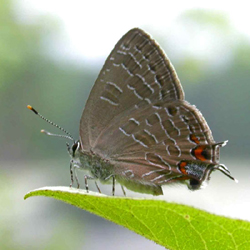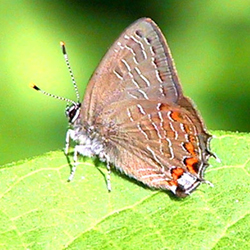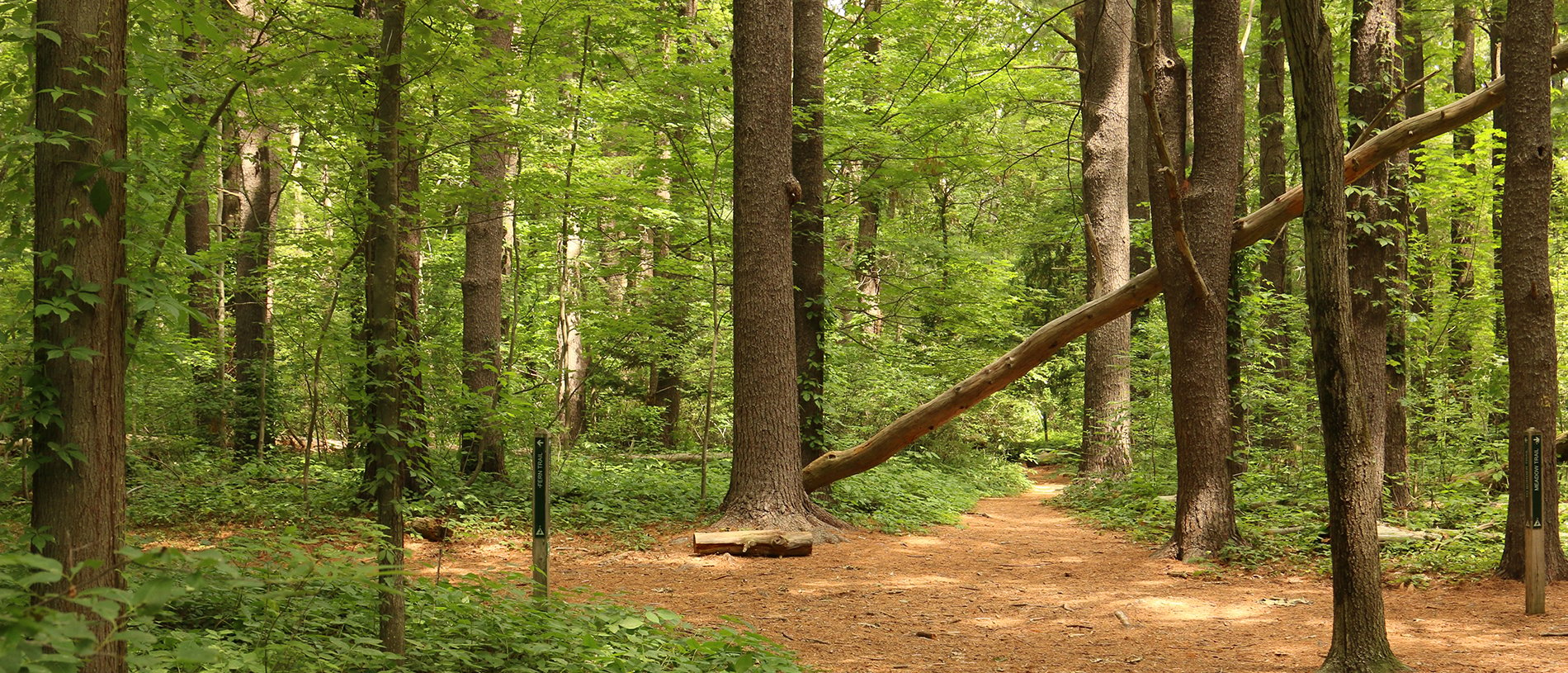Find a Butterfly
Striped Hairstreak
Satyrium liparops
Named
LeConte, 1833

Identification
Wingspan: 1 ‑ 1 3/8". Distinguished from other New England hairstreaks by pattern on underside of wings: wide, white‑bordered "stripes," broken into offsetting segments (not forming neat bands as in other hairstreaks). See accounts of Banded and Hickory hairstreaks for additional distinctions.
Distribution
Alberta east through southern Canada to Nova Scotia and south, east of the Rocky Mountains, to northern edge of the Gulf of Mexico from Texas to Florida. Known from the southern two‑thirds of New England.
Status in Massachusetts
Common throughout most of Massachusetts; uncommon on Cape Cod and unrecorded from the Islands during the Atlas years (historically present but scarce on both Nantucket and Martha‘s Vineyard ‑ Kimball and Jones, 1943). Most recent authorities state that the Striped Hairstreak is uncommon and local throughout its range, although Opler and Krizek (1984) allow that the species "may be common in southern New England." Scudder considered it rare in New England. Colonies may move about from year to year, but generally this is now a fairly easy butterfly to find in most parts of the state. Striped Hairstreaks are often found in populations of 5‑10 individuals. Maximum: 40, 16 July 1979, Millis (Norfolk Co.).

Flight Period in Massachusetts
One flight, typically from early July to early August. Extreme dates: 20 June 1986, Longmeadow (Hampden Co.), A. Southworth and 30 August 1992, Easton (Bristol Co.), B. Cassie.
Larval Food Plants
Many families of trees and shrubs utilized: Fire Cherry (Prunus pennsylvanica), Black Cherry (P. serotina), Chokecherry (P. virginiana), raspberries (Rubus, sp.)Apple (Malus pumilia); Hawthorns (Crataegus boyntoni and C. pruinosa); Thicket Shadbush (Amelanchier canadensis; Pear (Pyrus melancarpa); Mountain Ashes (Sorbus, sp ); Northern Red Oak (Quercus rubra); American Chestnut (Castanea dentata); Ironwood (Carpinius caroliniana); Paper Birch (Betula papyrifera); hickories (Carya, sp.); ashes (Fraxinus, sp.); Quaking Aspen (Populus tremuloides); Highbush Blueberry (Vaccinium corymbosum)
Adult Food sources
Milkweeds, mountain‑mints, dogbane, Meadowsweet, New Jersey Tea, and sumacs are preferred nectaring sources. Striped Hairstreak was found at 13 species during the Atlas period.

Habitat
Edges of deciduous woodlands, shrub thickets, and adjacent open areas.
Life Cycle
EGG: Reddish‑purple. OVIPOSITION: Eggs laid singly on host twigs and buds. LARVA: Bright green, with a darker stripe down the back and yellow‑green, oblique markings on the sides. In late spring, the larva emerges from the overwintering egg and begins feeding on host plant buds; later, fruits and leaves. Scudder noted the caterpillar‘s inactivity and its reluctance to leave one host leaf for another, even when the first was drying or decaying. CHRYSALIS: Yellowish‑brown with brown spotting. PUPATION: Takes two to four days, an exceptionally long time. Adults begin emerging from the chrysalis in early July and the species flies for about six weeks. Striped Hairstreaks spend a great deal of time perched on foliage, often in shrubby thickets along the edge of second‑growth deciduous woods.
Account Author
Brian Cassie



